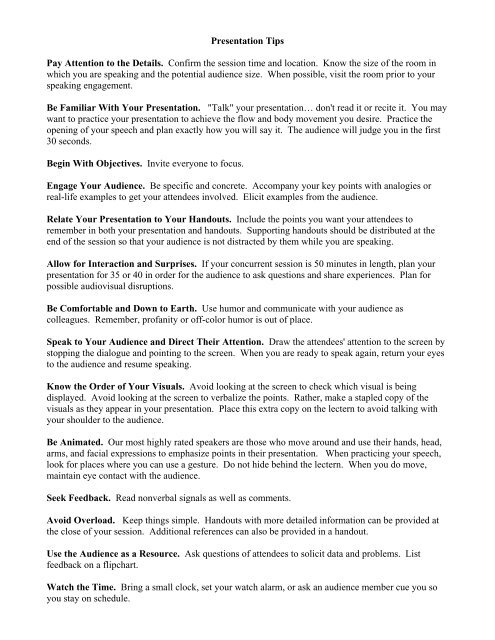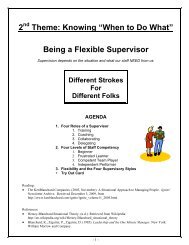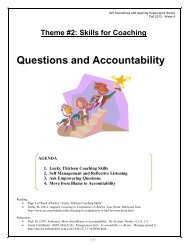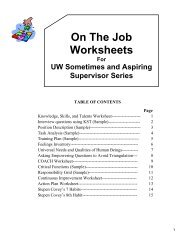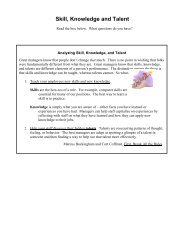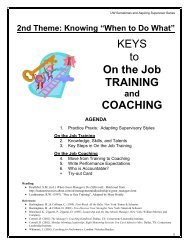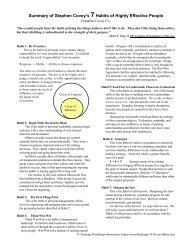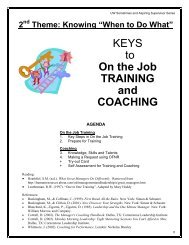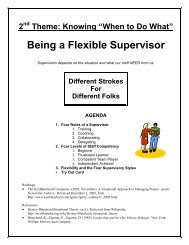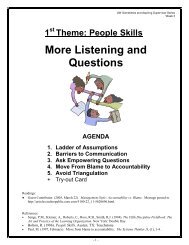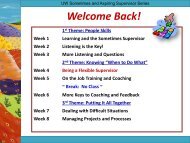Handouts
Handouts
Handouts
You also want an ePaper? Increase the reach of your titles
YUMPU automatically turns print PDFs into web optimized ePapers that Google loves.
Presentation TipsPay Attention to the Details. Confirm the session time and location. Know the size of the room inwhich you are speaking and the potential audience size. When possible, visit the room prior to yourspeaking engagement.Be Familiar With Your Presentation. "Talk" your presentation… don't read it or recite it. You maywant to practice your presentation to achieve the flow and body movement you desire. Practice theopening of your speech and plan exactly how you will say it. The audience will judge you in the first30 seconds.Begin With Objectives. Invite everyone to focus.Engage Your Audience. Be specific and concrete. Accompany your key points with analogies orreal-life examples to get your attendees involved. Elicit examples from the audience.Relate Your Presentation to Your <strong>Handouts</strong>. Include the points you want your attendees toremember in both your presentation and handouts. Supporting handouts should be distributed at theend of the session so that your audience is not distracted by them while you are speaking.Allow for Interaction and Surprises. If your concurrent session is 50 minutes in length, plan yourpresentation for 35 or 40 in order for the audience to ask questions and share experiences. Plan forpossible audiovisual disruptions.Be Comfortable and Down to Earth. Use humor and communicate with your audience ascolleagues. Remember, profanity or off-color humor is out of place.Speak to Your Audience and Direct Their Attention. Draw the attendees' attention to the screen bystopping the dialogue and pointing to the screen. When you are ready to speak again, return your eyesto the audience and resume speaking.Know the Order of Your Visuals. Avoid looking at the screen to check which visual is beingdisplayed. Avoid looking at the screen to verbalize the points. Rather, make a stapled copy of thevisuals as they appear in your presentation. Place this extra copy on the lectern to avoid talking withyour shoulder to the audience.Be Animated. Our most highly rated speakers are those who move around and use their hands, head,arms, and facial expressions to emphasize points in their presentation. When practicing your speech,look for places where you can use a gesture. Do not hide behind the lectern. When you do move,maintain eye contact with the audience.Seek Feedback. Read nonverbal signals as well as comments.Avoid Overload. Keep things simple. <strong>Handouts</strong> with more detailed information can be provided atthe close of your session. Additional references can also be provided in a handout.Use the Audience as a Resource. Ask questions of attendees to solicit data and problems. Listfeedback on a flipchart.Watch the Time. Bring a small clock, set your watch alarm, or ask an audience member cue you soyou stay on schedule.
Preparing a Presentation1) What is the purpose of this presentation? Can I state it in onesentence?2) What do I know about this topic that will relate to the main interestsof this audience?3) What are the main points I would like to share? Remember the Ruleof Three.4) Do I need to do additional research to prepare for this presentation?5) What supporting anecdotal information or documentation can Ishare?6) What will be the opening statement I use to get my audience’sattention? What will be my closing statement?7) Should I create supporting handouts or handouts of my visual aids?8) What is the best audiovisual means to display my message? Is theequipment available?9) Do I need to practice this presentation several times for my deliveryto seem natural?1
Your Audience is Important!1. Audience survey or “check-in” - prior to the session so thatyou can prepare better or ask upfront at the meeting what theaudience is looking for and then let them know if you will becovering that or not.2. Create meaning for the audience, in other words, “What’sin it for me?” Need to tailor the presentation to their needs. Itis important to remember that the presentation can onlyaccomplish your objectives if it is meaningful to the audience.How do you do this?a. Extemporaneous mode of speaking is the most effectivemode of delivery (conversational manner). This methodgives the impression that the speaker is simply talking withthe audience.b. Rapport – eye contact, sincerity, openness, be early togreet, voice and tone, shake hand, smile.c. Credibility – character, competence, composure,likeability, extroversion (avoid introversion or coming ontoo strong when presenting).d. Barriers – stereotypes, biases, conflicts of interest or notso-hiddenagendas, mistakes, appearing unprepared, flipflops(say one thing and then say something else later),exaggerations.3. Audience Reactions – look for lack of eye contact, confusedlooks, or body language to indicate they are not followingalong with the presentation. Important since you may be ableto make adjustments to your presentation.1
3D Strategy:1. Depersonalize - People come with their own emotionalbaggage and agendas. So don't take it personally.2. Detach - That means that you don't engage the ego. Once yougo head-to-head you set up a competitive dynamic. Don't letyour emotions get out of control. Ask questions to gainunderstanding. Don't get defensive.3. Defuse the negative energy. One of the best defusers is humor.Take a light, playful approach.2
Cast of CharactersCHARACTER DESCRIPTION HANDLING TECHNIQUEEager Beaver First to participate and eagerto help.Acknowledge their contributions andsuggest that others participate.NegativeVery resistant and negativeabout you, the subject matter,and doesn't want to be there.Begin to acknowledge his/her concerns.Recognize/acknowledge the difficultsituation. Deal with the problemComplainer/Whiner Finds fault with everythingbut has no solutions. He/shewill respond with "Yes, but"to your solutions.ExpertChallenges your authority;argues with others. This maytruly be a person withexpertise who wantsrecognition.RamblerDominatorSide-ConversationalistsHecklersThis is a storyteller. You askfor the time; you get thehistory of watch-making.This person wants to control.He/she may not be an expertbut can intimidate a group bymonopolizing theconversation or activity.Two or more people engage inregular conversations duringyour presentation.This person is disruptive andtries to gain audience attentionby making unnecessary orinappropriate remarks.immediately.Don't go there. This is a no win.Instead, ask the audience foralternatives. Stay focused and move on.Acknowledge comments withoutgetting defensive (remember,depersonalize, detach, defuse). Ask thegroup for other opinions. One of thebest strategies is to play to his/herexpertise. Invite and recognize theexpert's comments. Soon you will havean ally instead of an enemy.To manage the rambler, cut in politely,summarize the comments and ask forother opinions. Don't let them drone on.Don't let dominators take over. Ask forother responses. Use humor. Jokinglysay, "Someone other than Jerry." If thatdoesn't work, call a break and speak tothem privately.If it is a large auditorium, ignore it. Insmaller groups it can be distracting.Make eye contact with the talkers andstop speaking until they look up. Youcan also confront them directly and askthem to hold their conversation untillater. Or try the walk technique - walktoward them, stand in front of them, andkeep talking. They will get the message.Do not play their game. Try to ignorethem and continue your program. Ifthey are not getting a response fromyou, they may give up.“Making Good Presentations”Department of Public Instruction, 2003 kpl
Dealing with a Hostile Audience1) Listen carefully to the question and repeat it aloud. Make sure you understoodthe question correctly and that your audience knows the question to which you areresponding.2) Answer directly. Look directly at the person asking the question. Give simpleanswers to simple questions. If the question demands a lengthy reply, agree todiscuss it later with anyone interested.3) Refer to your presentation. Whenever possible, tie your answer to a point in yourspeech. Look upon these questions as a way to reinforce and clarify yourpresentation.4) Anticipate areas of questioning. Prepare factual support material in three or fourareas in which you anticipate questions.5) Be friendly and always keep your temper. A cool presentation creates an aura ofconfidence. When the questioner is hostile respond as if he or she were a friend.Any attempt to "put down" your questioner with sarcasm will immediately draw theaudience's sympathy to the questioner.6) Always tell the truth. If you try to bend the truth, you almost always will becaught. Play it straight, even if your position is momentarily weakened.7) Treat two questions from the same person as two separate questions.8) Don't place your hands on your hips or point at the audience. These arescolding poses and give you the appearance of preaching.9) Keep things moving. There is a rhythm to a good question-and-answer exchange.They volley back & forth in a brisk manner. Keep your answers brief and to thepoint with many members of the audience participating.10)Conclude smartly. Be prepared with some appropriate closing remarks. End with asummary statement that wraps up the essential message you want them toremember.“Making Good Presentations”Department of Public Instruction, 2003 kpl
The Components of Communication are:COMPONENTS OF COMMUNICATIONApril 29, 2009• Verbal - 7% of any message is communicated through words• Vocal - 38% of a message is relayed by your voice• Visual - 55% is conveyed by non-verbal body languageI. VISUALEYE CONTACTIf you regularly present to rooms of a couple dozen or more, you've probably had the experience of someonecoming up to you afterwards saying how much they enjoyed your talk. Meanwhile you're looking at themwondering where they were hiding because you're absolutely certain you never saw them until this instant.The issue here is eye contact. Most presenters have no trouble creating sincere eye contact when they're one onone with someone. But as the number of people increases unusual behaviors begin to emerge.What happens when you do make contact with the other person? How long are you in their eyes? Normally,people maintain eye contact for less and less time as the number of people in the room increases. If there's adozen or more, most presenters seem to have their eyes wired to some radar scanning program.As you think about eye contact for yourself, give yourself two challenges. First, tell yourself that you're going toincrease the amount of time you look at each person. Don't allow your eyes to move to someone else untilyou've reached an internal count of at least "three-Mississippi." Five Mississippi’s are even better.Second, play a game with yourself. Promise yourself some reward if, by the end of your presentation, you candescribe what everyone in the room is wearing. The point isn't to make you into some fashion maven, but toforce you to actually look at each person and register them consciously.Whether you're in a room of one hundred people or just two, looking each person in the eye is critical toestablishing trust. The truth is simple: unless your eye contact with each person is prolonged and sincere, youcan't succeed as a communicator.GESTURESLike vocal variety, gestures help alter the stream of input your watchers are receiving, and any new input is agood thing. As you become aware of your own gestures, ask some simple questions. First, what are your handsdoing when they're not gesturing? In other words, what's your neutral gesture?Some choices that do not convey confidence or leadership and should be eliminated as a neutral gesture:• Elbows fairly straight with your hands clasped in front of your groin;• Hands clasped behind your back;• One hand crossing your body to grasp the opposite elbow;• Both hands crossed over your chest.1
You might be wondering, "If that's the list of 'no-no's,' what is okay to do?"A nice neutral gesture has your hands in the center of your body, around belt height, with the fingertipslightly touching as if you're cradling a fragile glass ball. If that particular hand position feels awkward, findone that suits you better, but be cautious about hands clutching or grinding on each other. Your neutral gestureshould look relaxed.More importantly, when you do gesture, are your hands breaking your silhouette? They should. A small handflick that stays within the imaginary outline of your body does not earn the title of gesture. Push your comfortand gesture larger than feels comfortable. Ask people you trust whether your gestures look too big or unnatural.Odds are they'll look just fine. If your energy is upbeat and flowing freely, it is almost impossible to gesture toobroadly.If your concern is about using your hands too much, don't worry. You might be gesturing a lot, but that's not amajor reason to worry. Only worry if you find that you're making the same gesture over and over and over andover. Any repetitive behavior effects us like the monotonous clickety-click of a train. So mix it up and create awide array of gestures. That way your watchers won't be reaching for their mental remotes trying to changeyour channel.PHYSICAL PRESENCE or MOVEMENTEven the most senior level businesswomen are reluctant to adopt a small physical adjustment when presenting.The tendency for most presenters, even more pronounced in women, is to stand with their feet closer togetherthan their shoulders. Imagine a building wider at the top than at the base. Not a very solid image, is it?Spreading your feet as far apart as your shoulders may at first feel like you're imitating a wrestler on cable, butthis simple action can help ground you. It certainly will give you a more powerful look.When you're actually presenting, try to become aware of who you are physically. You might be a hip-swayer.Or you could be a knee-bouncer. Possibly you're one of the ever-popular move-shufflers, repeating a smallpattern of steps over and over as if it were a ritual dance. Or you might be the time honored slow-ambler. Theseseemingly calm presenters simply move continuously through their presentation space as if their private mantrawere: "It's hard to hit a moving target.None of these movement styles are going to have your watchers running screaming from the room, but they'renot going to enhance your look of leadership either. Think of it this way: any generalized, non-specificmovement is probably unconscious and habitual, like saying "um" with your body. If it doesn't add value, whydo it?The preferred style of movement has intention attached to it. One way to accomplish this is to feel confident instillness. For some people this can be even more difficult than being comfortable with silence. Spread your feetas far apart as your shoulders and put your weight over your toes, as if you're ready to spring forward. Then,when you make eye contact with someone, walk towards them.When you're at a comfortable distance from them, hang out there in that same feet-at-shoulder-width stance.Keep looking around and connecting with people. Then, next time you move, move towards someone else asyou look at them. Think of it this way. Habitual, generalized movement is like fluorescent lighting. It's2
oadband illumination, serviceable but not terribly attractive. Movement that has intention attached to it is likea laser, focused and powerful. Which would you rather be?II. VERBAL:CONCISE = SUCCESSExpressing ideas out loud for the very first time is exciting. It's like exploring a plot of land. You make yourway around the perimeter, viewing it from all angles. Then you make tentative prods to see what's beneath thesurface. Sometimes you end up back on the perimeter for another view or abandon the place altogether for awhole new plot. It's a fun process. Unless you're the listener.Under our definition of a presentation, you shouldn't need to do your exploring in front of other people. Theadvantage is that being concise is one of the most highly prized attributes of the effective communicator.To be concise you need to be able to deliver your last line first.It's said that when Jack Welch ran General Electric he asked presenters, "Do you have a summary slide?" Whenthey said yes, he said, "Show me that first." This is a terrific lesson, especially if you're communicatingupwards. Ask yourself, what point am I really trying to make? Then speak that first. All your reasons andsupporting data can come later.If you hear yourself beginning to repeat an idea, stop. That's right. Simply stop talking. Saying an idea out louda second time helps YOU clarify your thinking, it does not add value for your listeners. Think about it silentlyuntil you can summarize it in a sentence.As you challenge yourself to become more concise, you'll find yourself able to preface your remarks withframeworks like, "I have two different ideas regarding this," or "My thought connects directly with what Robinsaid."The sound of leadership is concise. Get to your bottom line. Say it once. Stop talking.People will listen.NONWORDS: ER'S AND AH'SNon-words are unconscious, habitual behaviors. They are highly personalized, individual marks of distinction.For example, some people have a perfectly articulated, resonant "um" at the head of their sentences. Others useonly the less distinct interior "uh." Often the word "and" becomes a non-word, linking idea after idea after ideain a run-on sentence that becomes unmanageable. Other non-words are actual phrases, such as "d'y'know what Imean" or "in a manner of speaking." No matter what the non-word, it is better left unsaid.The only way to reduce or eliminate non-words is to create a feedback loop. You might put a cassette recorderon your desk and hit the record button before you answer or dial the phone. Play back the tape on your wayhome from work. You'll be astonished. A week of that will change your habits fast!3
Or involve someone in your assault on that nasty non-word. Ask them to give you immediate feedback any timethey hear it. For example, you might be at lunch when you utter your "um." Your tablemate snaps her fingers.You hear her finger snap and become aware you just said an "um." You don't need to comment on her fingersnap, just recognize what just happened.If you can create good feedback loops, over time you'll move from having a habit that's completely unconsciousto knowing you're about to "um" but being unable to stop yourself. That's good.The final step will be to have the awareness a split second earlier ("I'm about to 'um'!") and actually have timeto substitute silence instead. Some people become concerned with why they use non-words. Is it an avoidanceof silence? Is it a way of keeping other people from talking? In truth, it really doesn't matter why. Like all thingspresentational, your listeners only care about what they observe. Just manage the behavior—in this case, thenon-words - and the why will become irrelevant.UNDERSTANDABILITYImagine you're one of a hundred people gathering at the edge of a mountain forest. A young, energetic rangerhas been hired to be your guide on a spectacular hike. When everyone's there your guide beams at you all andsays, "Listen, folks, this is a great hike. Don't worry about a thing. Ready? Let's go for it!" And she plunges intothe foliage.Are you comfortable plunging right in behind her? Probably not. But this is exactly what most presenters do totheir listeners: they plunge in, just assuming everyone's ready to barrel along with them. To enhance yourunderstandability, be a good guide. First, let people know where you're going to be taking them. In other words,tell them what they can expect to hear. Then, break your information up in manageable chunks. Number thechunks and give them simple one or two word headlines. Finally, use the numbers and the headlines repeatedly,like trail markers.Here's how this might sound:"Today I'm going to talk about the three elements that make up every successful presentation. First isCredibility. Number two is Understandability, and three is Memorability. Every skill and technique I talk aboutwill relate to one of those three elements. Okay? So let's start with number one. Credibility..."In print this might seem elementary or even condescending but spoken words are experienced very differentlythan the written word. Besides, nine times out of ten, you're the presenter because you're the expert. You knowmore about your subject than most of your listeners. So beginning in an elementary way isn't all bad. It's surebetter than plunging into the woods and leaving them all behind.So, to enhance understandability:Preview your material with a brief summary—no details yet. Break your material into chunks (ideally three,each of which can have sub-points).Give each chunk a one or two word headline. Announce each chunk by name and number when you get there.Summarize when you're done.4
III. VOCAL:PACEThe speed at which your thoughts are put together out loud. Normal conversational speech is done with rapidbursts of sound. Public speaking pace should be slower and more deliberate than conversational speech. Whatmay seem to be too slow to the speaker is very likely just right for the audience. The pace you choose may berelated to the kind of audience and content of your material. Aim for a slow pace, with lots of pauses betweenideas.Speed kills, especially when a talk is loaded with statistics, technical phrases, complex ideas. (Reading statisticsis safer than saying them from memory. You will sound more trustworthy.)RHYTHMWhen writers work to shape their prose, they have a weighty tool at their command: rhythm.Except for the word "rhythm," the entire previous sentence is written in iambic meter. An iamb is two syllables,the first unstressed, the second stressed. "Express" is an iamb. So is "rehearse." On the other hand, the word"rhythm" is a trochee, a stressed syllable followed by an unstressed syllable.How does this mini-lesson in meter relate to presentations? Because good writers, and good presenters, knowthat rhythm is most powerful when it changes.Shakespeare's plays, for example, are written predominantly in poetic lines of five iambs each (iambicpentameter), but it is rare that more than three or four lines at a time are in absolutely perfect iambic. Why?Because without variation the meter starts to dull the ear like the constant clakety-clakety of a train. (Singsong)As the speaker, you have a wide array of ways to use rhythm to give your listeners variety. One of the mostobvious is speeding up and slowing down. You can think of doing this with a long arcing vision—beginningan entire presentation at a moderate pace and then building and building the pace as you get farther along. Or itcan be done with a micro-view—altering your speed within individual sentences.A fun way to play with rhythm that many people use is to get to the end of a sentence and simply say one . . .word . . . at . . . a . . . time. If you need to communicate passion or importance, this is a simple and effectivetechnique.You might also examine whether all your ideas are expressed with sentences that are the same length. If yourlisteners can begin to predict how your ideas will be shaped, they'll stop listening.Many people fear they speak too quickly. This is rarely the case. Our ears can process more words per minutethan our mouths can articulate. But what is often missing is the full stop at the end of one thought before thenext thought begins. Using a pause is a powerful way to alter your rhythm and get people to tune in.(Do you remember your grade school teacher stopping speaking mid-sentence? Every head came up and alleyes went to her. Pauses have power!)5
As you look to create variety in your sound, play with the rhythm of your speech. One way to do this might beto imagine someone you know very well. Try imitating them with a particular emphasis on speaking in theirrhythm. Shifting your rhythmic gears builds flexibility and variety. And variety, after all, is the spice ofpresenting.VARIETY AND VOLUME1. Storytelling Tips from Toastmasters InternationalRemember, your goal is to convey the story to your listeners. You want them to be able to visualize thestory in their minds, as you did when you learned the story. You must make them experience the story withall of their senses, too. You can do this through your voice. Rehearse out loud so you can hear and feel thestory. As you practice your story, pay attention to the following:• Tempo: The tempo of your story should vary according to the action. For example, “Sleeping Beauty”is slow and dignified, while “Robin Hood” is firm and strong.• Inflection: An inflection is when the voice rises or drops at the end of a word. Inflections can addmeaning and emotion to words. Don't sound querulous. That is, don't end sentences with an upward toneas you do when you ask a question. (Unless you want to sound uncertain.) Beware of the inflections ofsarcasm; these inflections usually don't play well and can sound whiny and annoying.• Pause: Pauses heighten the interest of your listeners. Pause before changing ideas, before importantwords, or before important actions to create curiosity in your listeners.• Volume: Increase the volume of your voice to indicate excitement, surprise, or action. Lower yourvoice to a whisper to add suspense or emotion.6


